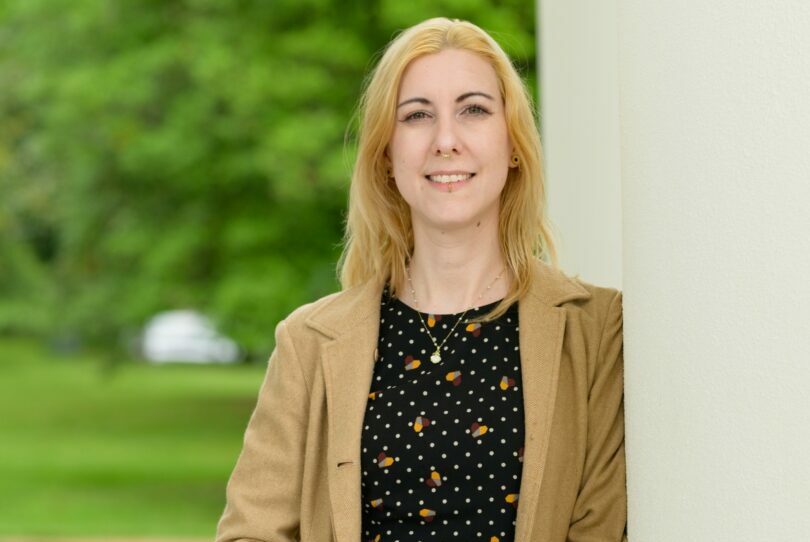We’re excited to introduce you to the always interesting and insightful Matthew Fields. We hope you’ll enjoy our conversation with Matthew below.
Matthew, so great to be with you and I think a lot of folks are going to benefit from hearing your story and lessons and wisdom. Imposter Syndrome is something that we know how words to describe, but it’s something that has held people back forever and so we’re really interested to hear about your story and how you overcame imposter syndrome.
Several years ago, on the self-help social media sphere, it was explained imposter syndrome is the natural part of the development and growth of an individual during skill acquisition. As a person acquires more skills or techniques, i.e., cooking, that person will start to realize and distinguish food with a more sophisticated palate. They may stop eating microwave meals because they have experienced a higher quality meal. This is not to say chicken nuggets are not delicious but compared to roast chicken, they are different culinary calibers.
This person may watch cooking shows or enroll in a culinary class, being exposed to elevated levels of culinary exhibitions and techniques. With more exposure and more practice, one becomes more confident in their skills. However, the flip side of the same coin is that this person then strives for better after each skill acquisition, simply not settling for mere adequate. This person may visit a 5-star Michelin restaurant and start thinking, “I’ll never be this good. I’ll never have these skills.” This stage in skill development is where imposter syndrome lives, like a grotesque monster lurking in a dank and musty cave.
Imposter syndrome comes from fear which can be crippling; stemming from rejection, past traumas, inadequacies, and lack of confidence to name some causes. Personally, imposter syndrome rears its ugly head when I feel that I do not know the information or draw a blank while chatting with a client. I brood over, “Am I competent enough? Did I sound like a babbling buffoon?” or “I’ll never be able to design a landscape like those in a magazine.”
Skill development is not a linear path, but instead a step function. As skills are acquired and developed, time is required for those skills to take hold. During that time, observations occur on improved methods. When the skills are improved, the insight of what constitutes higher standards increases due to this observation. The bar is constantly raised as new techniques or skills are acquired.
When I first started in landscape design, I did not like the ideas of performing sales calls or consultations. Up until then, I was always in a restaurant kitchen or bakery. I did not get much exposure to communicating directly with clients or sales aptitudes. Growing up, I had a speech impediment. Naturally, talking in front of others made me nervous, so I preferred back-of-house. I was uneasy, worrying that I was not going to be able to answer the client’s questions or trip over my words. Regardless, I knew I had to begin somewhere if I was going to start Fields Landscape Design. As I practiced landscape design and conversating with clients, I grew more confident in my abilities to articulate and demonstrate my horticultural knowledge.
While in horticulture class at Front Range Community College, the professor offered an idea that resonated. The idea is simple: most clients are people seeking out the advice of a professional. They are looking for guidance or counsel for their landscape needs and we would be those professionals. My professor suggested that if one does not know the answer, one can always tell the client that they can investigate and follow up with researched information.
This advice proved most helpful because it was reassurance, no one needed to be a walking horticulture textbook. I could use my resources to better help the client. When available, use resources; the internet has many reliable places to start researching.
With this assuring advice, I could always get back to a client after a sales call or consultation. It is important to remember that finding speedy solutions to questions is not necessarily the best solution when resources are at one’s disposal. If I space the name of a shrub or plant ailment, I will take a photo of the buds, leaves, flowers, pests, etc. to then research when I return to the office. Then, I can better inform the client with supplementary data.
Imposter syndrome, when explained as the natural progression of one’s talents, can be manipulated and weaponized. When used as a tool, fear can be utilized as ammunition to improve oneself and conquer challenges. When I feel rusty, unqualified, or unworthy, I reflect and determine precisely what I am lacking. Once I have identified the cause, I can decipher a solution. If I feel unsure of my education, I research and study ad nauseum. If I feel nervous about speaking, I practice my delivery.
When the overwhelming pressure of imposter syndrome occurs, taking time to reflect on the cause is important. Introspection is an ability that goes without measure for self-improvement. Being in touch with oneself is a way to better regulate and name what is causing the feelings of anxiety, nervousness, or apprehension. Identifying the cause of these feelings can help with the progress of a solution.
Introspection can build intuition. With intuition comes the ability to trust in oneself. Trust is powerful and needed in any relationship, however, it is often overlooked when applied to the relationship we have with ourselves. Feeling disconnected and needing to learn to trust myself, I attained new tools and techniques to help me build a relationship with myself. Meditation is an effective practice to start slowing the mind and channeling thoughts. Meditation is a practice, so it takes time and personal investment. One example of a grounding tool is meditation, but there are many other techniques worth exploring.
Imposter syndrome is the darker side of skill development which can be turned into a tool. As a person improves and comprehends higher criteria, benchmarks are placed for personal growth. The constant striving to improve, to be better, provides motivation but can cause anxiety or fear. Learning to be in touch with oneself allows for the issues to be identified and labelled. Once labelled, solutions can be fostered, and growth can begin; changing “I am not good enough” into an opportunity for expansion.
Thanks for sharing that. So, before we get any further into our conversation, can you tell our readers a bit about yourself and what you’re working on?
Fields Landscape Design is a sustainable, water conservation driven landscape design business. We specialize in native and xeric plantings to best conserve the rapidly depleting Colorado River. Xeric landscape can be more than barren rock mulch yards. Low water use plantings can provide a lush landscape and conserve Colorado’s precious water supply.
Offering sustainable and native alternatives to common green industry plants in Colorado landscapes is the primary mission of Fields Landscape Design. Each design is bespoken and caters to individual clients while providing water conservation alternatives for multiple seasons of interest. Planting plans are a collaborative coalition with clients so they get plants they will enjoy. A well-designed landscape can engage and connect people to their plants and wildlife.
The design process starts with an initial site consultation. We walk around the property and discuss the goals and desires of the landscape. From the information gathered at the site meeting, we generate a tailored design proposal that lists out the scope of design work and lays out the design process and fee structure. We break the design process into smaller phases to ensure that the client and designer are on the same page throughout the project.
Education is a cornerstone of our business principles. We educate our clients on the pragmatic outcomes for landscape elements. We paint realistic pictures and discuss the advantages and drawbacks to better aid in client expectations and the decision-making process.
As the landscape industry is adapting to the changing market, Fields Landscape Design persists with current native and xeric plants becoming available on the market. We design with the use of local nurseries in mind to keep business in Colorado.
Our landscape designs reconsider how Colorado landscapes can be when it is crucial to conserve precious resources. Reforming our landscapes starts with education and community.
There is so much advice out there about all the different skills and qualities folks need to develop in order to succeed in today’s highly competitive environment and often it can feel overwhelming. So, if we had to break it down to just the three that matter most, which three skills or qualities would you focus on?
Firstly, use tools and resources available. Asking for help is a resource that can often be overlooked. A community is imperative for growth. Collaboration with colleagues can lead to innovation and idea sharing. Every person has a uniquely personal perspective of the world. Their background, history, knowledge, and experiences can offer a different outlook.
Personally, reading is an incredible tool to gain perspective. A variety of non-fiction and fiction keeps the brain active and forms new connections. One could be watching “Arsenic and Old Lace” and connect a factoid learned at bar trivia; arsenic was used during the United States Civil War as an ingredient for embalming. That person could continue to read in another article and discover that sunflowers are able to absorb and remove arsenic from polluted soils.
Secondly, as a business owner, setting clear boundaries with clients and personally knowing the parameters helps navigate expectations through the design process. When starting a landscape design business, it is important to establish consistent fee structures for consultations and services. Guidelines determine how the business can handle services: internally, outsource it, or decline.
When self-employed, there can be a tendency to feel the constant magnetism to work. If I am not working, then Fields Landscape Design is not making income. Conversely, time to recharge is essential. One cannot give from an empty cup. To prevent burnout, I make the commitment to myself not to work on Sundays or the evenings. These are the times to spend with my partner when he is home or with our little pups Quinn and Vivian. The two little ladies are a steady reminder to be present.
Lastly, do not monetize every hobby or task. When we monetize all aspects of our lives, we start to feel the pressure to perform constantly, thus removing the joie de vivre. Play is important for the creative process and allows the brain to make connections that may not be apparent. Play can lead to innovation.
At our home, we have a small vegetable garden. The highlight of the year is watching our pumpkins grow over the season. It is a reminder that the world continues to grow with or without worry, so take the time to play and enjoy life.
Before we go, any advice you can share with people who are feeling overwhelmed?
When I find myself overwhelmed, I take a step back and collect myself. I take my two dogs outside for fresh air and a new view. Changing scenery is an effective, small step to remove anxiety. I take several deep breaths, focusing on my breaths and trying to become present. Grounding techniques can look different for others: taking a walk, going on a country drive, reading, or gardening. The goal is to practice mindfulness regardless of the tasks to become more grounded.
Once I calm down and ground myself, I can assess what is causing these feelings. If the feeling stems from an overloaded workload, I start by prioritizing my tasks. In an outline format, I sort and list tasks by importance and relevance to the project. The list can then be broken into practicable pieces. For me, the laundry can wait another day when compared to the deadline pressure to complete a design.
Electronic outlines are handy techniques to add notes, time frames, and updates as needed to the list of tasks. Occasionally, I will list “Make outline” as a simple reward for starting the task. It is motivation to continue to chisel away the rest of the list. The outline then becomes a visual representation of the project and more manageable.
If there are areas that I can get support, then I will ask for assistance from colleagues, friends, or family. From time to time, the need to carry the burden of the world’s expectations can be what causes the feeling of being overwhelmed. Learning to ask for help is a great way to share the burden and gain some relief.
Sometimes the feeling of being overwhelmed is rooted in negative thought patterns. For myself, these thoughts come in the form of “what if this goes bad.” Changing those negative thoughts to “what if it goes right” opens the mind to be more receptive to opportunity. Comparative, it is like when car shopping and the car being test driven is now spotted everywhere on the road. Our brains are already prepared to be responsive to those details. However, like meditation or cooking, it takes practice and repetition.
When feeling overwhelmed, I take the time to analyze the causes by using mindfulness, a practice to help channel thoughts. Knowing the problem opens the possibility to find solutions. Visual representations such as lists or outlines can help with task-oriented anxiety while delineating the overall project into workable stages. Positive thinking helps keep the brain open to possibilities.
Contact Info:
- Website: https://www.fieldslandscapedesign.com/
- Instagram: https://www.instagram.com/fieldslandscapedesign/
- Facebook: https://www.facebook.com/FieldsLandscapeDesign/
- Linkedin: https://www.linkedin.com/in/matthew-fields-294226113/
- Twitter: https://twitter.com/FieldsLandscape






Image Credits
Fields Landscape Design LLC




